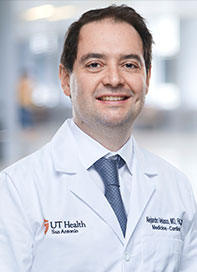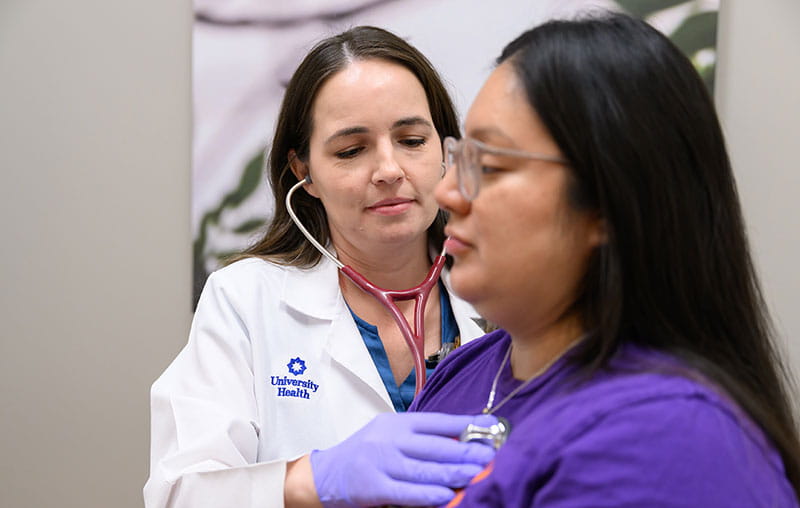Cardiologists have used implantable devices to treat heart conditions for years. Within the past few years, a new option — cardiac contractility modulation (CCM) — has become available. University Health heart doctors are among the few providers in the nation to offer this treatment.
CCM is a device that improves the overall function of the heart. The device stimulates the heart with timed electrical pulses throughout the day. Patients with a CCM device experience reduced symptoms and enjoy a better quality of life.
Dr. Alejandro Velasco De La Cuesta is a cardiac electrophysiologist at University Health. Cardiac electrophysiologists specialize in the electric activity in the heart. “Any patient with heart failure whose symptoms haven’t improved with medication can be considered for cardiac contractility modulation,” Velasco says.
Treatments for Heart Failure
In addition to CCM devices, University Health offers other treatments for heart failure.
Implantable Cardioverter-Defibrillators
These life-saving devices can be implanted transvenously or subcutaneously (under the skin). They prevent sudden cardiac death in people at high risk for cardiac arrest.
This device is usually inserted transvenously, but for patients at higher risk for infection or for very young patients, electrophysiologists implant it under the skin without the need for wires inside blood vessels.
Cardiac Resynchronization Therapy
This is similar to a conventional pacemaker except the leads are placed on both the right and left ventricles of the heart, rather than only the right ventricle, to resynchronize the heart in a more natural way. These devices are often used for patients with heart failure due to electrical desynchrony. Someone who has had a pacemaker for many years may develop heart failure as a result of lack of synchrony between the right and left ventricle, so cardiac resynchronization therapy can be a good alternative in those cases.
When medications are not reducing a patient’s symptoms, they can be complemented with a device-based therapy to improve patient outcomes. However, an implantable cardioverter-defibrillator is typically the first line treatment for patients at high risk of cardiac arrest.
Device-Based Therapy Research at University Health
The University Health heart team is involved in implantable device research. Velasco is currently researching conduction system pacing and left bundle branch pacing for cardiac resynchronization.
This technology involves implanting a pacemaker close to the normal conduction system of the heart, simulating a more physiologic activation of the heart. He says this technology is showing promising outcomes so far.
What to Expect
Cardiac electrophysiologists at University Health implant heart devices daily, in a procedure that lasts approximately two to three hours. Patients are sedated, sometimes under general anesthesia, and are able to go home the next day.
Recovery time is typically short with few restrictions, such as only light physical activity for one week. Most patients are back to their normal activities within a week. These devices don’t limit patients’ use of cell phones or electronic equipment, and they don’t restrict travel by plane.
“If a provider has any questions about whether a patient might benefit from one of these devices, refer the patient to us,” Velasco says. “Don’t worry about whether a patient meets specific criteria; we can find options for them.”
Heart Care at University Health
Learn more about the award-winning heart care at University Health on our website.





